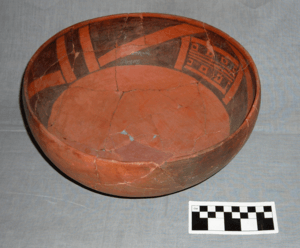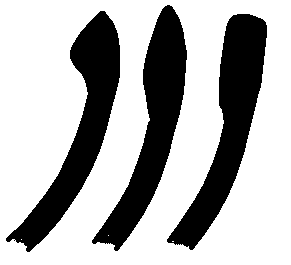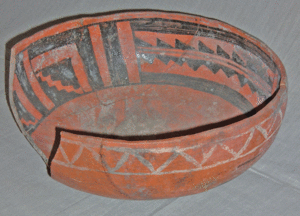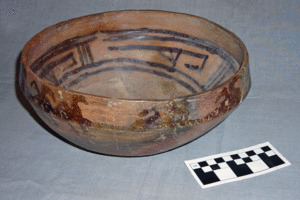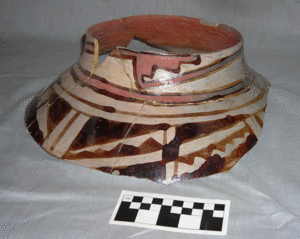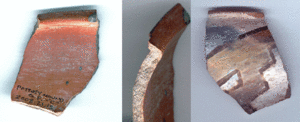Rio Grande Glaze Ware facts for kids
Rio Grande Glaze Ware is a special type of pottery made by the Puebloan peoples in New Mexico long ago. This pottery was made from about 1315 AD until 1700 AD. Potters painted designs on the pots using black paint made from lead. When the pots were fired in a hot oven, this lead paint would melt and become shiny, like a glaze. Sometimes, the paint would even run a little.
This unique pottery was made and used in many villages. These villages stretched from the Santa Fe area in the north down to the Elephant Butte Reservoir in the south. They also extended from the Rio Puerco valley in the west to the upper Pecos River Valley in the east.
Archaeologists, who study ancient cultures, divide Rio Grande Glaze Ware into different types. This helps them figure out how old a site is based on the pottery pieces found there. They look at things like the shape of the pot's rim and the painted designs to identify each type.
Contents
Understanding Glaze Ware Pottery
Rio Grande Glaze Ware first appeared around 1315 AD. We know this from tree-ring dating at a place called Tijeras Pueblo. This new pottery style slowly took the place of an older type of pottery called black-on-white pottery. The idea for glaze ware came from the White Mountain Red Ware tradition. This older style was popular in eastern Arizona and western New Mexico.
The earliest type of Rio Grande Glaze Ware was probably Los Padillas Polychrome. It was a local version of a White Mountain Red Ware type. This early pottery is often found at sites where black-on-white pottery was common.
How Glaze Ware Was Made
Rio Grande Glaze Ware was fired in an oven with lots of oxygen. The special lead-based paint turned black and shiny, even with all that oxygen. Other paints, made with iron, turned a dull red. Often, red designs were outlined with the shiny black glaze paint.
The background colors of the pots could be red, olive, or yellow. These colors came from different clay slips, which are thin layers of liquid clay applied to the pot. Sometimes, a white background was made using special clay brought from the Acoma-Zuni region.
Why Glaze Ware Production Ended
After 1700 AD, Rio Grande Glaze Ware was no longer made. This happened because the Spanish, who had colonized New Mexico, stopped the Pueblo people from getting the lead ore. This lead was essential for making the glaze paint. The Pueblo people continued to make colorful pottery, but they used dull, non-shiny paints, just as they do today.
Unlike some pottery from other parts of the world, Rio Grande Glaze Ware used the glaze only for decoration. It was never used to cover the whole pot to make it waterproof.
Pottery and Pueblo Life
Some experts believe this new pottery was part of changes in religious practices among the New Mexico Pueblos. Large glaze ware bowls were likely used for big community feasts. Each family would bring food to share in these bowls. Smaller white ware bowls were used for everyday meals.
Later, smaller glaze ware bowls also became common. This meant glaze ware bowls were used for both special feasts and daily eating.
Identifying Pottery by Rim Shapes
Archaeologists often sort pottery pieces by the shape of their rims. This is because rim shapes changed over time, making them good clues for dating a site. They use letters A through F to describe the different rim styles, with A being the oldest and F being the newest.
Glaze A Rims (1315-1425 AD)
Glaze A bowls have rims that curve inward and are the same thickness all around. The very edge of the rim is either rounded or squared. Glaze A pottery was made from about 1315 AD to 1425 AD in the northern areas. However, in the southern parts, these rims were made until 1500 AD or even later.
The first Glaze A pottery was made near Albuquerque. Most of these pots were red with black designs inside. Sometimes, simple designs like crosses were painted on the outside. This type is called Agua Fria Glaze-on-red. Some very early examples had simple white designs on the outside, known as Arenal Glaze Polychrome or Los Padillas Polychrome.
As Glaze A pottery spread north, yellow pots appeared. These are called Cieneguilla Glaze-on-yellow. If they had red matte paint outlined in black, they were Cieneguilla Glaze Polychrome. Some Glaze A pots had different colors inside and outside. If they had only black glaze paint, they were San Clemente Glaze Polychrome. If they also had red matte paint, they were Pottery Mound Polychrome.
A few Glaze A pots had slightly flared rims. These were called Sanchez Glaze-on-red or Sanchez Glaze-on-yellow. If they had white inside and red outside with black glaze paint, they were Sanchez Glaze Polychrome.
Glaze B Rims (1400-1450 AD)
Glaze B bowl rims also curve inward but get thicker towards the edge, which is flat. This makes the rim look a bit like a wedge. Glaze B pottery was mostly made north of Albuquerque. In the south, potters kept making Glaze A style rims. Glaze B dates from about 1400 AD to 1450 AD.
Glaze B pots with one color and black glaze paint are called Largo Glaze-on-yellow or Largo Glaze-on-red. The yellow ones are more common. If they had one color and red matte paint outlined in black, they were Largo Glaze Polychrome.
Glaze C Rims (1425-1500 AD)
Glaze C bowl rims have edges that turn outward. This style was made between 1425 AD and 1500 AD. There is one main type for this rim group: Espinoso Glaze Polychrome. These pots have red matte paint designs outlined in black glaze paint. The bright colors made Espinoso pots look "flashy." During the Glaze C, D, and E periods, most pottery designs were very colorful.
Glaze D Rims (1470-1515 AD)
Glaze D bowl rims were made between 1470 AD and 1515 AD. The outside of the rim often bends inward slightly. The rims are usually a consistent thickness or get a little thinner towards the pot's body and the lip. The main type for this rim group is San Lazaro Glaze Polychrome. These pots have red matte paint outlined in black glaze paint. Both the inside and outside of the bowls have designs in panels or bands. The black paint is thin but does not run.
Glaze E Rims (1515-1700 AD)
Most Glaze E bowl rims are much thicker than the rest of the bowl. You can often see "breaks" or sudden changes in the curve on the outside of the bowl. After the Spanish arrived in New Mexico in 1598, some glaze ware bowls started to look like European dishes, such as soup plates. The black glaze paint on Glaze E pots often ran during firing. Glaze E was made from 1515 AD until 1700 AD.
There are three main types of Glaze E bowl rims. Puaray Glaze Polychrome has thick rims that look like willow leaves, with a clear break on the outside. The designs included red matte paint outlined in runny black glaze. If the rims are more rectangular, the type is Escondido Glaze Polychrome. In the Pecos Pueblo area, Glaze E rims were sometimes "stubby," meaning the thick part was short and close to the rim. This type is called Pecos Glaze Polychrome.
Glaze F Rims (1625-1700 AD)
Glaze F pottery shows a big drop in the quality of the glaze and how well it was made. Glaze F bowl rims still have a break on the outside, but they are not as thick as Glaze E rims. Pots with European-inspired shapes became even more common. The glaze paint used then often turned runny brown or green when fired, instead of black.
Glaze F pots with one color and "black" glaze paint are called Kotyiti Glaze-on-red or Kotyiti Glaze-on-yellow. There are several design types under Kotyiti Glaze Polychrome. Some have one color and red matte paint outlined in "black" glaze paint. Others have two different colors and either "black" glaze paint or red-and-black paint.
Identifying Pottery by Paint Styles
Another way to classify Rio Grande Glaze Ware is by its painted designs. This method looks at whether the design uses only black paint or a mix of red and black paint.
Black Painted Designs
The first Rio Grande Glaze Ware pots continued an old tradition of black designs on a lighter background. The next step is to look at the background color: was it red, yellow, or different colors on the inside and outside?
Red Backgrounds
Arenal Glaze Polychrome and Los Padillas Polychrome bowls have red backgrounds with simple black glaze designs inside. Arenal uses crushed rock in the clay, while Los Padillas uses crushed pottery pieces. The outside of these bowls has simple white matte paint designs. This style (black-on-red inside, white-on-red outside) came from White Mountain Red Ware. Arenal was made from about 1315 AD to 1350 AD and is found from Albuquerque south.
Agua Fria Glaze-on-red is similar to Arenal but does not have white paint on the outside. Agua Fria bowls are red. The black glaze paint is usually dull and does not run. The black designs are often in bands on the upper inside of the bowls. The upper outside sometimes has simple marks like slashes or crosses. Jars with black-on-red designs also exist. Agua Fria Glaze-on-red was made throughout the Rio Grande Glaze Ware area. It dates from 1315 AD to 1425 AD, and even later in the south. A version of Agua Fria Glaze-on-red with a slightly flared rim is called Sanchez Glaze-on-red. This type is found north of Albuquerque and dates from 1350 AD to 1425 AD.
When Glaze B rims are present instead of Glaze A, this type becomes Largo Glaze-on-red (1400 AD to 1450 AD). Later, all-black designs seemed to disappear until the Spanish Colonial period. During that time, some pots went back to this simpler design. If Glaze F rims are present, this type is called Kotyiti Glaze-on-Red (1625 AD to 1700 AD).
Yellow Backgrounds
When the background color is more yellow than red, pots with black designs are called Cieneguilla Glaze-on-yellow. This style is found north of Albuquerque and might have been a local invention as glaze ware pottery spread north. Cieneguilla dates from 1325 AD to 1425 AD. In the Galisteo Basin, a version with a slightly flared rim is known as Sanchez Glaze-on-yellow (1350 AD to 1425 AD).
When Glaze B rims are present, black-on-yellow bowls are called Largo Glaze-on-yellow (1400 AD to 1450 AD). After this, all-black designs seemed to die out until the Spanish Colonial period. During that time, if Glaze F rims are present, the type is Kotyiti Glaze-on-yellow (1625 AD to 1700 AD).
Contrasting Backgrounds
Early on, potters also learned to make pots with different background colors on the inside and outside. They used red and yellow clays, and sometimes white clay likely brought from the west.
San Clemente Glaze Polychrome dates from about 1315 AD to 1425 AD. In this type, the inside and outside of each bowl have different colors. The black glaze paint designs often include dots and jagged lines. San Clemente Polychrome is found from Albuquerque south.
A rare version of San Clemente Glaze Polychrome is Sanchez Glaze Polychrome. It has a slightly flared rim, similar to Glaze C rims but thicker. These bowls are found north of Albuquerque.
Later, a type appeared with black paint designs on contrasting inside and outside colors, with Glaze F rims. This is called Kotyiti Glaze Polychrome. However, the same name is used for Glaze F rim pots with red-and-black designs.
Red and Black Painted Designs
Soon after glaze ware began, potters in the Rio Grande area started adding red paint to their designs, along with black. Where red (dull) paint was used, it was almost always outlined with black glaze paint. This style might have been inspired by Ramos Polychrome, a pottery type from northwest Chihuahua. The next question is: was the background color a single color, or different colors?
Single Background Colors
The use of red-and-black designs probably started on yellow pots. Over time, other background colors were used. The first type in this tradition was likely Cieneguilla Glaze Polychrome. It is like Cieneguilla Black-on-yellow but with added red matte paint outlined in black glaze paint. Cieneguilla Polychrome dates from 1325 AD to 1425 AD. When Glaze B rims are present, this type becomes Largo Glaze Polychrome (1400 AD to 1450 AD).
When Glaze C rims are present, the type is Espinoso Glaze Polychrome (1425 AD to 1500 AD). By this time, the background color was often off-white instead of yellow, making the designs look "flashier." This might have been an imitation of pottery from the Acoma-Zuni area. Espinoso Glaze Polychrome is most common north of Albuquerque.
When Glaze D rims are present, the type is San Lazaro Glaze Polychrome (1470 AD to 1515 AD). The background color went back to a tan-reddish range. Sometimes, the red matte paint was not used, making these examples technically glaze-on-red, not polychrome.
When Glaze E rims are present, the type is Puaray Glaze Polychrome (willow-leaf rims; 1515 AD to 1650 AD) or Escondido Glaze Polychrome (rectangular rims; 1515 AD to 1650 AD). Jars, like the one shown, always fall under Puaray. The background color can be off-white, yellow, or red. By this point, the black glaze paint was "runny" during firing, making the finished pots look a bit messy. It is not clear if this was on purpose or due to changes in the materials. In the Pecos area, a local version called Pecos Glaze Polychrome has "stubby" thick rims. This type dates from 1515 AD to 1700 AD.
When Glaze F rims are present, the type is Kotyiti Glaze Polychrome (1625 AD to 1700 AD). This same name is also used for Glaze F rim examples in the San Lazaro (two slip) tradition. Kotyiti Glaze Polychrome is known for its quick, less careful designs and runny black glaze paint.
Contrasting Background Colors
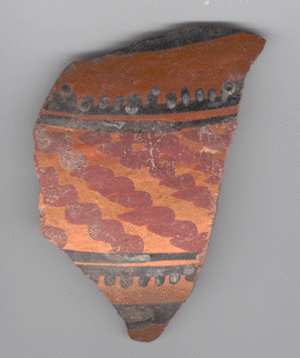
Pottery Mound Polychrome is seen as a version of San Clemente Glaze Polychrome. It combines the San Clemente idea of different slip colors inside and outside with the red matte paint outlined in black glaze paint. Some bold examples of this type even have red matte paint designs not outlined in black. The contrasting background colors included red (sometimes orange), yellow (sometimes olive), and white (likely from Acoma area clay). Pottery Mound Polychrome dates from 1400 AD to 1490 AD. It was only made at Pottery Mound, a village on the lower Rio Puerco.
Some archaeologists divide this pottery into two types. "Pottery Mound Polychrome" describes Glaze A rim bowls with yellow to buff inside and red outside, dating from 1375 AD to 1450 AD or later. "Hidden Mountain Polychrome" describes Glaze A or C rim bowls with red inside and white outside, dating from 1400 AD to 1450 AD or later.
Different Ways to Classify Pottery
The Mera system, which starts by looking at rim shapes, works best for the northern part of the glaze ware area. This is because Mera developed his system based on pottery from that region.
A newer approach, developed by Franklin (2007), is better for the southern part of the glaze ware area, where the Mera system does not work as well. Franklin's system recognizes that rim shapes and painted designs do not always fit neatly together. For example, in his system, a bowl with black glaze paint on a red background is always called "Agua Fria Glaze-on-red," no matter its rim shape. The rim shape (A, B, etc.) is then recorded separately. This method is more flexible. For instance, in one older system, Pottery Mound Polychrome is listed as a Glaze A type. However, at the actual production site, Pottery Mound, it is found with other rim shapes.


